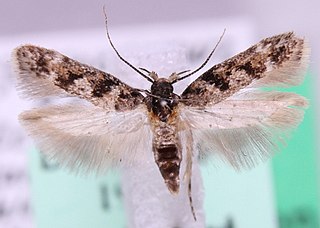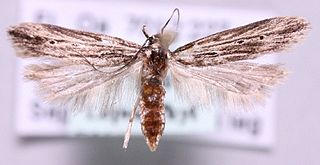
Athrips mouffetella is a moth of the family Gelechiidae. It is found from central and northern Europe to the Ural Mountains, Siberia and the Russian Far East. It has also been recorded from North America.

Recurvaria leucatella is a moth of the family Gelechiidae. It is found in most of Europe, Turkey, Central Asia and the Caucasus.

Chrysoesthia sexguttella, the orache leafminer moth, is a moth in the family Gelechiidae. It is found in all of Europe, east to southern Siberia, as well as the north-eastern parts of North America, where it might be an introduced species.

Syncopacma cinctella is a moth of the family Gelechiidae. It is found in all of Europe, Asia Minor and North Africa. In the east, the range extends through Siberia to the Russian Far East.

Prolita sexpunctella, the long-horned flat-back or groundling, is a moth of the family Gelechiidae. It is found in most of Europe and North America.

Eulamprotes wilkella is a moth of the family Gelechiidae. It is found in most of Europe. Outside of Europe, it is found in Turkey, the Caucasus and Siberia.

Syncopacma taeniolella is a moth of the family Gelechiidae. It is found in most of Europe.

Bryotropha politella is a moth of the family Gelechiidae. It is found in Ireland, England, Scotland and the Massif Central in France.

Bryotropha umbrosella is a moth of the family Gelechiidae. It is found in open dune areas throughout most of north-western Europe. In southern Europe, it is only known from one record from Spain.
Monochroa suffusella, the notch wing neb, is a moth of the family Gelechiidae. It is found from Fennoscandia to the Pyrenees and Alps and from Ireland to Romania. In the east, the range extends to Japan. The habitat consists of bogs, fens, swamps and salt-marshes.

Caryocolum alsinella is a moth of the family Gelechiidae. It is found throughout Europe It is also present in North Africa.

Chionodes distinctella, the eastern groundling, is a moth of the family Gelechiidae. It is found in almost all of Europe, as well as most of Russia, Kazakhstan, Central Asia and North Africa. The habitat consists of dry, rocky heath and meadows and the verges and rough pastures.

Ptocheuusa paupella, the light fleabane neb, is a moth of the family Gelechiidae. It is found from central and southern Europe to the Ural Mountains. It is also found in Turkey and India.

Monochroa palustrellus, the wainscot neb, is a moth of the family Gelechiidae. It is found in from western, central and northern Europe to the Ural Mountains and southern Siberia. The habitat consists of waste ground, dry pastures and sand-dunes.

Teleiodes luculella, the crescent groundling, is a moth of the family Gelechiidae. It is found from Europe to the southern Ural and Transcaucasia. The habitat consists of woodlands, including oak woodlands.

Gelechia sororculella, the dark-striped groundling, is a moth of the family Gelechiidae. It is widely distributed from Europe, throughout Siberia to the Russian Far East.

Monochroa tenebrella, the common plain neb, is a moth of the family Gelechiidae. It was described by Jacob Hübner in 1817. It is found in most of Europe. The habitat consists of open grassy areas and heathland.

Syncopacma sangiella, the brown sober, is a moth of the family Gelechiidae. It was described by Henry Tibbats Stainton in 1863. It is found in most of Europe, except the Benelux, Denmark and parts of the Balkan Peninsula.

Eulamprotes atrella, the two-spotted neb, is a moth of the family Gelechiidae. It was described by Michael Denis and Ignaz Schiffermüller in 1775. It is found from most of Europe, east to Japan. The habitat consists of mixed deciduous woodlands.

Eulamprotes unicolorella, the unmarked neb, is a moth of the family Gelechiidae. It was described by Philogène Auguste Joseph Duponchel in 1843. It is found in almost all of Europe. The habitat consists of wastelands and dry open areas.


















